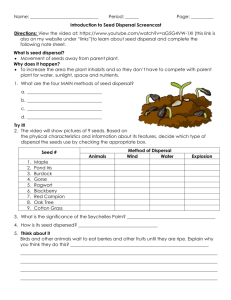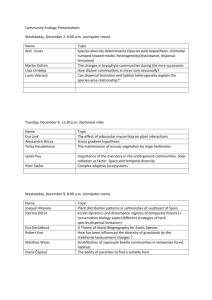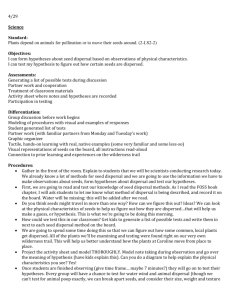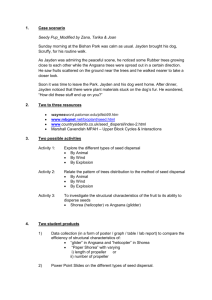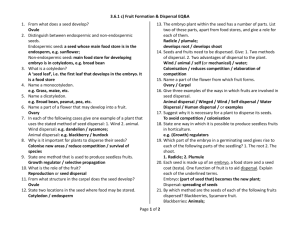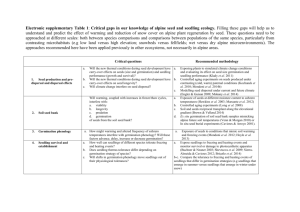Final Report - Rufford Foundation
advertisement
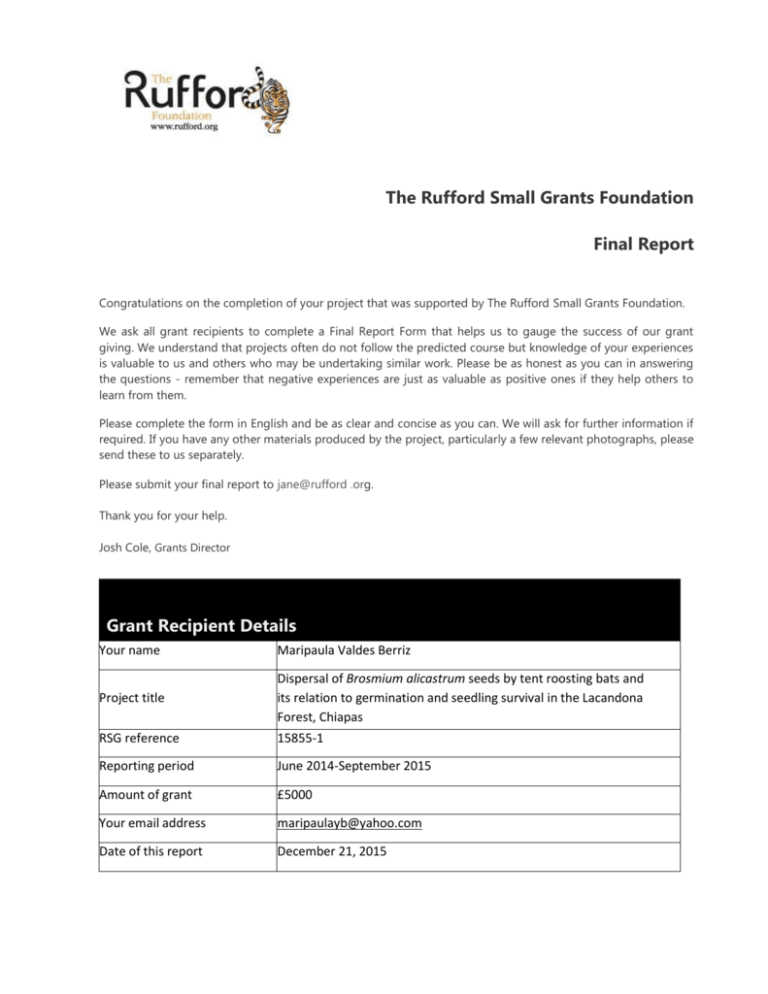
The Rufford Small Grants Foundation Final Report Congratulations on the completion of your project that was supported by The Rufford Small Grants Foundation. We ask all grant recipients to complete a Final Report Form that helps us to gauge the success of our grant giving. We understand that projects often do not follow the predicted course but knowledge of your experiences is valuable to us and others who may be undertaking similar work. Please be as honest as you can in answering the questions - remember that negative experiences are just as valuable as positive ones if they help others to learn from them. Please complete the form in English and be as clear and concise as you can. We will ask for further information if required. If you have any other materials produced by the project, particularly a few relevant photographs, please send these to us separately. Please submit your final report to jane@rufford .org. Thank you for your help. Josh Cole, Grants Director Grant Recipient Details Your name Maripaula Valdes Berriz Project title Dispersal of Brosmium alicastrum seeds by tent roosting bats and its relation to germination and seedling survival in the Lacandona Forest, Chiapas RSG reference 15855-1 Reporting period June 2014-September 2015 Amount of grant £5000 Your email address maripaulayb@yahoo.com Date of this report December 21, 2015 1. Please indicate the level of achievement of the project's original objectives and include any relevant comments on factors affecting this. Objective Determine the effect of bat dispersal to tents and other feeding roosts on germination Not achieved Partially achieved x Determine the effects of distance, density and canopy cover on germination Determine the effects of dispersal on the rate of germination Determine the effects of dispersal to tents and other feeding roosts on seedling survival Determine the effects of distance, density, canopy cover and initial seedling size on survival Determine the effects of dispersal on seedling survival time Fully achieved x x x x x Comments Some seed removal may have occurred before the study began, and it was not accounted for in the total number of seeds used to calculate germination percentages. It was not possible to completely separate the effect of distance and site since they were somewhat correlated, smaller distances corresponding to parental trees and larger distances to bat dispersal sites. 2. Please explain any unforeseen difficulties that arose during the project and how these were tackled (If relevant). Fruiting of Brosimum alicastrum occurred later than usual and as a result as I was not in the field when fructification started. Therefore, the method that had been proposed to evaluate germination success could not be implemented. To obtain this data, I changed the method and counted the seeds within the 1m2 quadrat; the trees had finished fruiting by the time the study started. Although it had not been more than a week since the trees' fructification ended, we cannot account for seed removal that occurred during that period of time, which could be high. The germination percentages should be used taking this into account. Using other data from another study on seed dispersal to tent roosts, I will discuss how this might have affected the estimates for germination of seeds dispersed to bat tents. 3. Briefly describe the three most important outcomes of your project. Seed dispersal by bats has a positive effect on germination even at short distances from parental trees and when dispersed in clumps under feeding roosts. Seed dispersal by bats increases seedling survival even at short distances from parental trees and the effect can still be detected 14 months after germination. Seedlings under feeding roosts with and without tents are larger than under parental trees. 4. Briefly describe the involvement of local communities and how they have benefited from the project (if relevant). Involvement with the local community was done through elementary and middle schools. We (me with the help of colleagues) visited the classrooms and gave presentations to the students about the importance of seed dispersal by bats and specifically talked about tent roosting bats and their peculiarities. I also developed some lessons for different grade levels to teach about tent-roosting bats, the importance of seed dispersal by bats. In the future, these materials will be organised within a booklet that can be distributed to the teachers in the local area and anybody else that wants to use them for educational purposes. 5. Are there any plans to continue this work? Yes, we are planning to continue the research on the effects of seed dispersal by bats. The next stage of this research will study the effects of seed dispersal in forest fragments and will try to address the question of dispersal distances in a fragmented landscape with the aim to determine the contribution of bats to maintaining connectivity among patches. 6. How do you plan to share the results of your work with others? The results of the research were presented in the North American Symposium for Bat Research (NASSR) in Monterrey, California in November of this year. Data that is still being analysed will be presented in other international events in the future. The results will also be published in international peer reviewed journals. 7. Timescale: Over what period was the RSG used? How does this compare to the anticipated or actual length of the project? The funds from the RSG were used during the period of November 2014 to September 2015. However, part of the funds were used to make payments that were pending since June 2014 when the project started. The study was proposed to end in March of this year, but I decided to monitor seedling survival in September 2015 to assess the effect of the present year's fructification on the surviving seedlings and determine if the effect of dispersal could still be detected 14 months after germination. 8. Budget: Please provide a breakdown of budgeted versus actual expenditure and the reasons for any differences. All figures should be in £ sterling, indicating the local exchange rate used. The actual amounts were calculated using the exchange rate used to calculate the budgeted amounts to make them comparable, which was 21.95 MXN pesos per £ sterling. The local guide performed some of the monitoring activities on the months when the trips were cancelled. Item Budgeted amount 2825 Actual amount 2232 Difference Comments 593 Lodging 1366 637 729 Food Local guide 683 114 328 1517 355 1403 Material 0 90 55 To balance the budget some trips were cancelled, which reduced the cost of transportation (not gas and oil). Lodging costs for reduced for the reason above. Reduced costs as above Payment to the local guide was much higher than expected and other costs had to be reduced. Some material that were used in Transportation plus gasoline and motor oil the field and educational activities. Total 9. 4988 4804 184 Looking ahead, what do you feel are the important next steps? The next step is to start looking at the effects of seed dispersal by bats in forest fragments and disturbed areas. There are many factors that could affect the dynamics in those sites. It is also important to look at the factors that could affect seed dispersal such as the plant species used by the bats as feeding roosts, fruit/seed availability and dispersal distances. In general, the next steps should be more focused on the practical applications of this research and how we can successfully use the services of bats as effective seed dispersers to enhance successional processes, maintain connectivity and increase diversity in fragmented landscapes. 10. Did you use the RSGF logo in any materials produced in relation to this project? Did the RSGF receive any publicity during the course of your work? Included the RSGF logo in my presentation at NASBR, and it will be included in the educational materials when these are finished and distributed. 11. Any other comments? We also had support from a grant from Bat Conservation International. Bioconciencia A.C. gave the funds, which allowed the project to start; the funds were later returned when the grants became available. We hope to continue this research next year to start working in forest fragments and answer other questions that have come up during this work that are relevant to the practical applications of this project. The next steps will be very important to be able to make recommendations.

